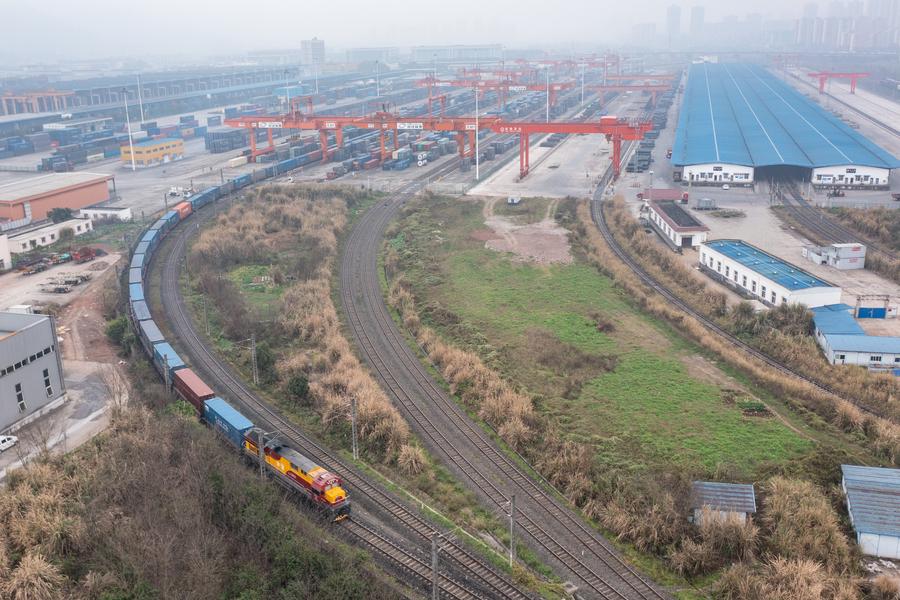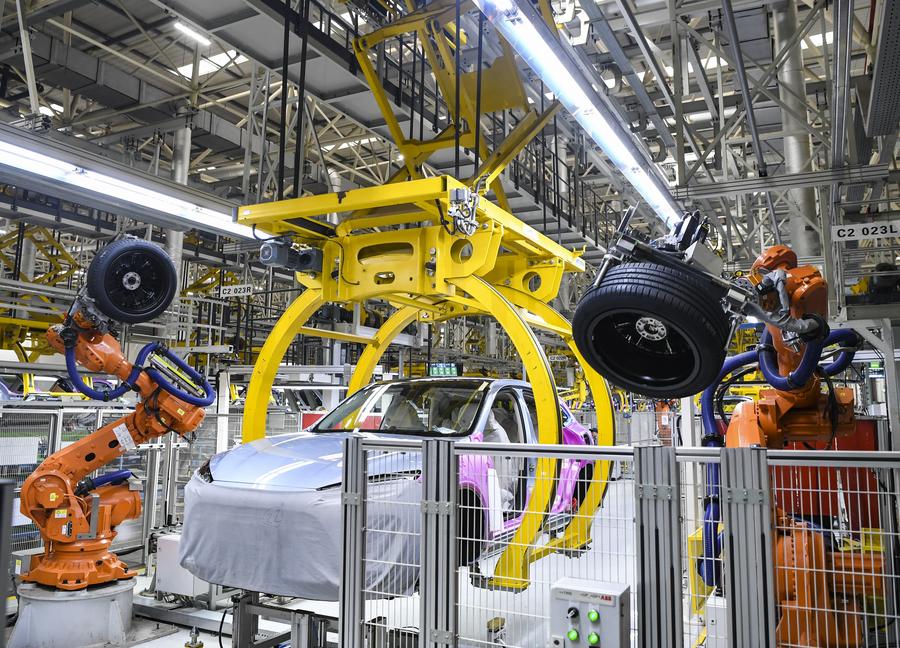

A China-Europe freight train loaded with machinery, automobiles and auto parts waits for departure at a railway station in Chongqing, southwest China, March 7, 2024. (Xinhua/Huang Wei)
Chengdu, capital of Sichuan Province, and neighboring Chongqing Municipality, both located in southwestern China, are emerging as dynamic regions leading the way in further opening up and development in the country's western regions.
Latest customs data shows that, in the first two months of this year, the combined foreign trade of Chongqing and Sichuan reached 259.13 billion yuan (about 36.5 billion U.S. dollars), marking a 6.2 percent increase compared with the same period last year.
Since the implementation of the development plan for the Chengdu-Chongqing economic zone in 2021, the customs departments of the two cities have closely cooperated to help build a highland for reform and opening up in the inland region of China. According to the Chongqing Customs, these efforts have taken effect and accelerated the development of the economic zone.
The recovery of imports and exports is a microcosm of the Chengdu-Chongqing region's coordinated efforts to expand comprehensive and high-level opening up in all aspects.
With a population of over 98 million, the Chengdu-Chongqing economic zone is another important regional development strategy in China. It follows similar initiatives in the Beijing-Tianjin-Hebei region, the Yangtze River Delta, and the Guangdong-Hong Kong-Macao Greater Bay Area.
Renowned Chinese poet Li Bai of the Tang Dynasty (618-907) once wrote a poem titled Shu Dao Nan, depicting the region's poor transportation. It described how dangerously high and steep the way to Shu (Sichuan Basin) was and more difficult than ascending the blue sky.
However, the hinterland has now been transformed from a once remote and isolated inland area to a crucial locality along the Belt and Road Initiative and the Yangtze Economic Belt, becoming a new highlight of opening up in western China.
In 2023, the Chengdu-Chongqing economic zone achieved a regional GDP of nearly 8.2 trillion yuan, an increase of 6.1 percent year on year.

An aerial drone photo taken on March 7, 2024 shows a China-Europe freight train loaded with machinery, automobiles and auto parts pulling out of a railway station in Chongqing, southwest China. (Xinhua/Huang Wei)
In terms of railway development, Chongqing and Chengdu were among the first cities in China to offer China-Europe freight train services. As a significant step in constructing the Chengdu-Chongqing economic zone, the two cities have cooperated since 2021 to improve the China-Europe freight train service.
In January and February, Chengdu and Chongqing handled over 650 China-Europe freight trains, transporting more than 70,000 TEUs (twenty-foot equivalent units) of cargo.
The China-Europe freight train services handled by the two cities currently reach 110 cities in Europe and Asia. The range of goods transported has expanded from laptops to over ten thousand types of commodities, including vehicles and parts, communications and mechanical equipment, pharmaceuticals, and medical devices.
To facilitate the development of the new land-sea transit routes for the western region, Chongqing and Chengdu have been making joint efforts and playing important roles as a logistics and operation organization center and an important national commercial and trade logistics center, respectively.
Chongqing Lee & Man Paper Manufacturing Limited used to import raw materials from Southeast Asia. It had long been troubled by the lengthy cycle of river-sea transportation. Thanks to the new land-sea transit routes, the company's logistics challenges have been effectively addressed.
"The routes improve the efficiency of the supply chain, reducing transportation time by about 15 days. This has shortened the company's production cycle, significantly increased output, and improved efficiency," said Huang Zhicong, the company's general manager.
Meanwhile, an increasing number of specialty products from western Chinese regions, such as herbs from Gansu Province, nuts from Xinjiang Uygur Autonomous Region, wolfberry and red wine from Ningxia Hui Autonomous Region, and tea from Guizhou Province, can now reach the world via the routes, with some becoming new growth points for local foreign trade.
In addition, the two localities are working together to promote the construction of a world-class airport cluster, which will accelerate the opening of more international passenger and cargo air routes.
On Tuesday, a themed meeting was convened in Chongqing, emphasizing the vigorous promotion of the construction of the Chengdu-Chongqing economic zone as a key task to enhance the development of China's western region.

This photo taken on June 27, 2022 shows a vehicle being assembled at a smart factory of Chinese vehicle manufacturer Seres Group in Liangjiang New Area, southwest China's Chongqing Municipality. (Xinhua/Wang Quanchao)
Today, an increasing number of foreign enterprises have identified the great potential of the western regions and have been attracted to settle down there.
Data shows that foreign direct investment (FDI) in Sichuan and Chongqing accounts for about 50 percent of the total FDI in western China.
In 2023, Chongqing established 321 new foreign-invested enterprises, an increase of 30.49 percent year on year, while the actual foreign investment in Sichuan rose to 24.52 billion yuan.
Last month, the multinational enterprise Danaher, specializing in life sciences, diagnostics, and biotechnology, signed a strategic cooperation agreement with Chongqing Liangjiang New Area to jointly establish an innovation center.
"We look forward to the construction of the innovation center, building it into a high-level precision medicine and integrated platform for biopharmaceutical innovation in the Chengdu-Chongqing region," said Peng Yang, global vice president of Danaher and president of Danaher China.
Suez Group, a global expert in the water and waste sectors, has invested over 4 billion yuan in Chongqing. It regards China's carbon-neutrality pledge as a great opportunity for the company's development in the country.
The Chengdu-Chongqing economic zone is one of the main engines of China's future economic growth. The group is very optimistic about the growth prospects of this region, said Sabrina Soussan, chairwoman and CEO of Suez Group.
The first training camp of the Center of Innovation and Maritime Excellence, supported by Chinese companies, was opened Thursday in Djibouti City, the capital o...